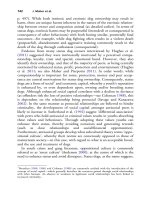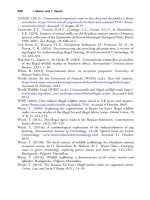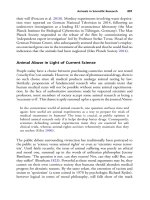The palgrave international handbook of a 147
Bạn đang xem bản rút gọn của tài liệu. Xem và tải ngay bản đầy đủ của tài liệu tại đây (25.87 KB, 1 trang )
138
J. Maher et al.
Punitive Training
Developments in understanding dog behaviour through positive training
methods are not widely understood in society and this is perhaps more
acute within status dog ownership. Without appropriate training, dog owners depend on unreliable advice from ‘old-timers’, their peers, or the internet.
In Hughes et al. (2011) all youths indicated problems with basic behaviours
such as toilet training and recall on command. Problems with training
include:
• Training methods ordinarily involving physical and mental punishment
(for example, hitting, kicking, starving, placing in solitary confinement for
long periods) and the use of harsh paraphernalia (prong collars, electric
collars)
• Training to enhance aggression and frustration (for example, encouraging
aggression towards objects, people and other animals, by hanging dogs
from branches by the mouth, pulling heavy objects, and putting irritants
in their eyes)
• Physical punishment used in an attempt to stop the dog displaying natural
behaviours (for example, not coming on command off-lead, chewing
household items, urinating/defecating inside and fear of other dogs)
• Using the dog in an offence (for example, training to be aggressive in a
robbery)
Dog Fighting
Hughes et al. (2011) found youths did not engage in traditional organised dog
fighting, but rather ‘rolling’ dogs on chains, or releasing dogs in confinded
public space as part of a bet, or fighting dogs as a way to resolve group conflict.
Youths widely believed their dogs wanted and needed to fight and that it forms
a natural part of their behaviour. When dog fighting resulted in injury
veterinary treatment was unlikely to be provided.
Abandonment and Destruction
With youths’ purchasing or acquiring dogs on a whim, it can place them in
conflict with their parents or carers. Frequently youths identified themselves as
the sole owner of their dog, although they were seldom able to provide the









